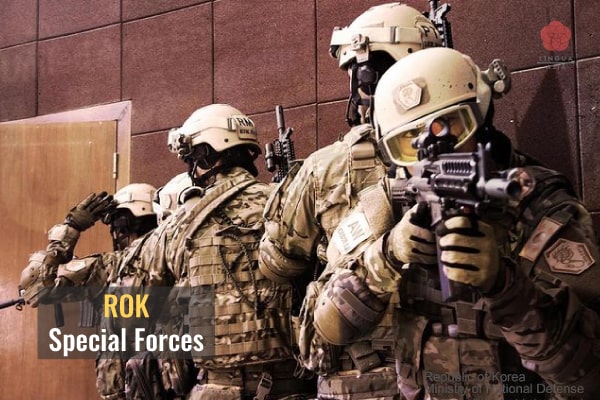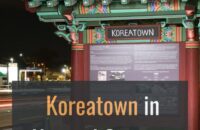
Here are 7 Korean special forces units, how they train and what they specialize in!
Quick Summary
- Korean special forces are an essential part of the defense capabilities of the country, which has technically been at war for decades.
- South Korean special forces include the Army Special Warfare Command, the 707th Special Mission Group, and the Naval Special Warfare Flotilla (UDT/SEAL).
From sharpened bamboo poles to fight off samurai to night vision goggles used to spot North Korean infiltrators, Korea’s defensive capabilities have improved a lot.
What is a Korean special force?
Special forces are units with trained personnel that specialize in reconnaissance, espionage, covert operations, subversive activities, psychological warfare and counterterrorism.
South Korean special forces include the Army Special Warfare Command, the 707th Special Mission Group, and the Naval Special Warfare Flotilla (UDT/SEAL).
1. Naval Special Warfare Flotilla (UDT/SEAL)
“Nothing is impossible”
The Naval Special Warfare Flotilla is a special operations force of the Republic of Korea Navy formed in November 1955 after the Korean war. It’s widely known as UDT/SEAL.
In the early days, this special force only performed as an Underwater Demolition Team (UDT), but is currently in charge of Explosive Ordnance Disposal (EOD), Sea, Air and Land (SEAL) strikes, and maritime Counter-Terrorism (CT) missions.
The unit successfully conducted operations, including:
- the search for an infiltrating spy ship off the coast of Dadaepo, Busan in 1983
- a search operation inside a North Korean Yugo-class submarine in 1998
- Operation Dawn of Gulf of Aden (rescued Korean chemical tanker Samho Jewelry from Somali pirates in the Arabian Sea) in 2011
Less than 40% of applicants pass 12 weeks of basic fitness training. Trainees must complete over 3.6km (2.23 miles) of swimming barefoot, 7.2km (4.47 miles) of swimming with fins, 40km (24.85 miles) of running and 40 pull-ups.
2. Army Special Warfare Command
“Make the impossible possible”
“Approach like a ghost, strike like lightening, vanish like smoke”
Army Special Warfare Command is a strategic-level military command of the ROK Army in charge of special operations forces, founded in August 1969.
It’s also known as the Army Special Forces “Black Berets”.
The unit infiltrates deep into the enemy’s rear areas by parachuting from aircraft and takes on missions like reconnaissance, surveillance, destruction of major military facilities, assassination of key enemy leaders and rear sabotage.
The Black Berets participated in
- Vietnam War
- 1999 East Timorese crisis
- Operation Enduring Freedom
- Iraq War
3. Marine Corps Reconnaissance Unit
“Stealth, Speed, Accuracy”
The ROK Marine Corps Reconnaissance Unit is a special force at the forefront of landing operations.
Currently, it’s the most combative and practical unit within the Marine Corps.
The unit infiltrates the enemy coastal area in advance through air, sea, underwater and ground maneuvers to perform foresight operations, serving as the eyes and ears of the landing force. It also collects intelligence on the enemy’s size, activities, weather and topography.
The Reconnaissance Unit is the top 1% elite force of the ROK Marine Corps as they go through intensive and professional training.
Just like UDT, the Recon Unit has a Hell Week where trainees have to cross a mountain and sea while carrying a rubber boat weighing over 100kg (220.46 pounds) without sleep for 132 hours (5.5 days).
4. Sea Salvage & Rescue Unit (SSU)
“Into a wider and deeper sea!”
Sea Salvage & Rescue Unit (SSU) is a special force for maritime disasters/accidents.
The Navy SSU has the highest level of underwater operation capability, founded in September 1950.
In peacetime, the unit performs operations like maritime and air rescue, and investigates marine accidents involving aircraft and ships. In wartime, it performs combat rescue missions and supports the opening of major ports.
The SSU successfully performed:
- rescue during the sinking of the MV Seohae in 1993
- salvage of Chamsuri Warship no. 357 at the Battle of Yeongpyeong in 2002
5. 6th Search & Rescue Air Group
“Any time, Any place, Saving a Life!”
Also known as the Special Airforce Rescue Team (SART), the 6th Search & Rescue Air Group is a special force under the Air Force in charge of search and rescue missions throughout the Korean Peninsula, founded in August 1958.
Their main missions are:
- search and rescue in wartime and peacetime
- rescue of pilots in distress
- lifesaving in case of incidents/accidents
- VIP airlift
- cargo airlift
- emergency patient airlift in remote areas
6. Air Force Combat Control Team (CCT)
“First there, last out”
The Combat Control Team (CCT) is the smallest special force unit of elites, formed in 1978.
The team performs mobile air traffic control and counterterrorism missions.
It also provides information to allied aircraft on weather, wind direction and speed, and controls altitude and azimuth to facilitate safe transport.
The CCT performed:
- air traffic control for Korean aircraft in East Timor in 2000
- weather survey together with the Daiman Unit stationed in Kuwait for airlifts to the Iraqi battlefield in 2005
- Operation Miracle in Afghanistan in 2021
7. 707th Special Mission Group
“Represent logic with actions, and prove process with results”
With the symbol of a white tiger, the 707th Special Mission Group is a special force under the Republic of Korea Army Special Warfare Command, formed in 1981 by selecting only elite members.
It’s a national counter-terrorism unit that also performs special operations like top-secret missions at the national level.
They train with the US Delta Force.
In the 1980s, the very existence of the 707th Special Mission Group was classified, and mentioning them in media was prohibited.
Since the late 1990s, secrecy has somewhat eased, and the unit has become known to the general public.
But it’s still highly classified, keeping the identities of members unknown. They rarely disclose training details. All members are masked or camouflaged with sunglasses, even when interviewed by media.
Some notable missions completed by the 707th Special Missions Group are:
- Armed Deserter Hostage Takeover Case at Chupungnyeong Service Area in 1986 where an AWOL sergeant carrying explosives and an M16 automatic rifle held 19 intercity bus passengers hostage for 18 hours at Chupungnyeong service area. The 707th shot the deserter and saved all the passengers.
- Saemmul Church Missionary Hostage Case in Afghanistan in 2007 where church members were kidnapped and murdered by the Taliban. The 707th went to Afghanistan and prepared for a hostage rescue operation. Luckily, most hostages were released after negotiations.









